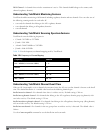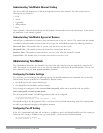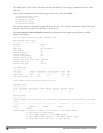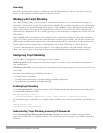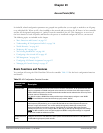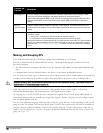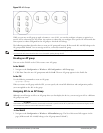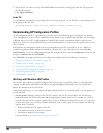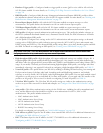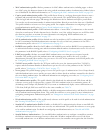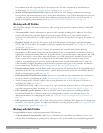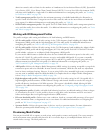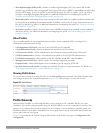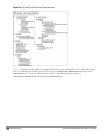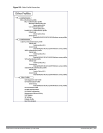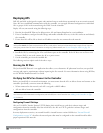
l Handover Trigger profile— Configure a handover trigger profile to ensure QoS for voice calls for APs with the
802.11k feature enabled. For more details, see "Enabling Wi-Fi Edge Detection and Handover for Voice Clients"
on page 709
l RRM IEprofile—Configure a Radio Resource Management Information Element (RRMIE)profile to define
the information elements advertised by an AP with 802.11k support enabled. For more details, see "Working with
Radio Resource Management Information Elements" on page 336
l Beacon Report Request Profile—APs with the 802.11k feature enabled use request messages to solicit
measurements. This profile defines the information an AP can send in beacon report requests.
l TSMReport Request Profile—APs with the 802.11k feature enabled use request messages to solicit
measurements. This profile defines the information an AP can send in traffic stream measurement reports.
l SSID profile—Configures network authentication and encryption types. This profile also includes references to
the EDCA (enhanced distributed channel access) Parameters Station Profile, the EDCA Parameters AP Profile
and a High-throughput SSID profile.
Use this profile to configure basic settings such as 802.11 authentication and encryption settings, or advanced
settings such as DTIM (delivery traffic indication message) intervals, 802.11a/802.11g basic and transmit rates,
DHCP settings and WEP keys. The advanced SSID profile settings allows you to deny broadcast probes and hide
the SSID. For details on configuring an SSID profile, see "Creating a new SSID Profile" on page 324.
NOTE: Beacon rates for 802.11a and 802.11g beacon should only be configured on APs with Distributed Antenna Systems (DAS).
Configuring beacon rates during normal operation may cause connectivity problems.
l High-throughput SSID profile—High-throughput APs support additional settings not available in legacy APs. A
High-throughput SSID profile enables/disables high-throughput (802.11n) features with 40 MHz channel usage,
and define values for aggregated MAC protocol data units (MDPUs) and Modulation and Coding Scheme (MCS)
ranges. If you modify a currently provisioned and running high-throughput SSID profile, your changes take effect
immediately; rebooting is not required. For details on configuring a high-throughput SSID profile, see Table 95.
l Virtual AP profile—This profile defines your WLAN by enabling or disabling the band steering, fast roaming and
DoS prevention features. It defines radio band, forwarding mode and blacklisting parameters, and includes
references to an AAA Profile, 802.11K Profile, and a High-throughput SSID profile. You can apply multiple virtual
AP profiles to an AP group or to an individual AP; for most other profiles, you can apply only one instance of the
profile to an AP group or AP at a time. For details on configuring a Virtual AP profile, see Table 88.
l VIA client WLAN profile—The VIA client WLAN profile settings are similar to the authentication settings
used to set up a wireless network. For details and examples, see "Configure VIA Client WLAN Profiles" on page
562.
l AAA profile—This defines authentication settings for the WLAN users, including the role for unauthenticated
users, and the different roles that should be assigned to users authenticated via 802.1x, MAC or SIP
authentication. This profile includes references to:
l MAC Authentication Profile
l MAC Authentication Server Group
l 802.1X Authentication Profile
l 802.1X Authentication Server Group
l RADIUS Accounting Server Group
For details on configuring an AAA profile, see "AAA Profile Parameters" on page 319.
l XML API server profile—Specifies the IP address of an external XML API server. For additional information, see
"Configuring the XML API Server" on page 779.
l RFC 3576 server—Specifies the IP address of a RFC 3576 RADIUS server. For additional information, see
"Configuring an RFC-3576 RADIUS Server" on page 171.
DellPowerConnectW-SeriesArubaOS6.2 | User Guide AccessPoints(APs) | 397



